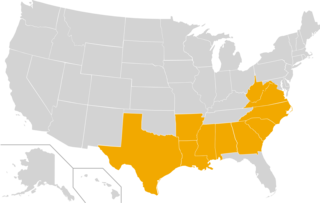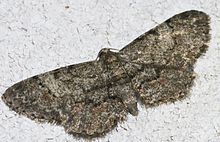
The Sun Belt Conference (SBC) is a collegiate athletic conference that has been affiliated with the NCAA's Division I since 1976. Originally a non-football conference, the Sun Belt began sponsoring football in 2001. Its football teams participate in the Division I Football Bowl Subdivision (FBS). The 14 member institutions of the Sun Belt are distributed across the Southern United States.
A condemned prisoner's last meal is a customary ritual preceding execution. In many countries, the prisoner may, within reason, select what the last meal will be.

Tornado Alley is a loosely defined location of the central United States and Canada where tornadoes are most frequent. The term was first used in 1952 as the title of a research project to study severe weather in areas of Texas, Louisiana, Oklahoma, Kansas, South Dakota, Iowa and Nebraska. Tornado climatologists distinguish peaks in activity in certain areas and storm chasers have long recognized the Great Plains tornado belt.

The 100 metres, or 100-meter dash, is a sprint race in track and field competitions. The shortest common outdoor running distance, the 100-meter (109.36 yd) dash is one of the most popular and prestigious events in the sport of athletics. It has been contested at the Summer Olympics since 1896 for men and since 1928 for women. The inaugural World Championships were in 1983.

Charles Rene Strong is an American football coach who was most recently the co-defensive coordinator and linebackers coach at the University of Miami. He recently served as the assistant head coach and inside linebackers coach for the Jacksonville Jaguars of the National Football League (NFL) in 2021 and also previously served as a defensive analyst at the University of Alabama in 2020.

Sean Baker is an American filmmaker. He is best known for directing independent feature films about the lives of sex workers, including Starlet (2012), Tangerine (2015), The Florida Project (2017), Red Rocket (2021), and Anora (2024), the last of which won the Palme d'Or at the 2024 Cannes Film Festival. He is also known for creating the Fox/IFC puppet sitcom Greg the Bunny (2002–2006) and its spin-offs.

Florida is a state in the Southeastern region of the United States. It borders the Gulf of Mexico to the west, Alabama to the northwest, Georgia to the north, the Atlantic Ocean to the east, and the Straits of Florida and Cuba to the south. About two-thirds of Florida occupies a peninsula between the Gulf of Mexico and the Atlantic Ocean. It has the longest coastline in the contiguous United States, spanning approximately 1,350 miles (2,170 km), not including its many barrier islands. It is the only state that borders both the Gulf of Mexico and the Atlantic Ocean. With a population of over 21 million, it is the third-most populous state in the United States and ranks eighth in population density as of 2020. Florida spans 65,758 square miles (170,310 km2), ranking 22nd in area among the states. The Miami metropolitan area, anchored by the cities of Miami, Fort Lauderdale, and West Palm Beach, is the state's largest metropolitan area, with a population of 6.138 million; the most populous city is Jacksonville. Florida's other major population centers include Tampa Bay, Orlando, Cape Coral, and the state capital of Tallahassee.
The Big 12 Conference is a conference of 16 universities which participate in the National Collegiate Athletic Association's Division I Football Bowl Subdivision football. The conference formed in 1994 and begin conference play in the fall of 1996. The schools that compose the Big 12 Conference, except for Arizona, Arizona State, Brigham Young, Central Florida, Cincinnati, Utah, and West Virginia, were members of either the Big Eight Conference or the Southwest Conference, and have won 21 national titles including 3 titles since the inception of the Big 12 Conference.

Eugene Marquis "T. Y." Hilton is an American football wide receiver who is a free agent. He played college football for the FIU Panthers and was selected by the Indianapolis Colts in the third round of the 2012 NFL draft. Hilton has also played for the Dallas Cowboys.

Callionima parce, the parce sphinx moth, is a species of moth in the family Sphingidae.It was originally described by Johan Christian Fabricius in 1775.

Xanthopastis regnatrix, the Spanish moth or convict caterpillar, is a moth of the family Noctuidae. It occurs in the United States, where it is found from North Carolina to Texas and south to Florida. Strays have been recorded as far north as coastal New York, and inland as far north as Kentucky.

The Florida Women's Hall of Fame is an honor roll of women who have contributed to life for citizens of the US state of Florida. An awards ceremony for the hall of fame was first held in 1982 and recipient names are displayed in the Florida State Capitol. The program was created by an act of the Florida Legislature and is overseen by the Florida Commission on the Status of Women (FCSW), a nonpartisan board created in 1991 to study and "make recommendations to the Governor, Cabinet and Legislature on issues affecting women". The FCSW also manages the Florida Achievement Award for those who have improved the lives of women and girls in Florida, an award is focused on outstanding volunteerism. FCSW members serve by appointment and the commission is housed at the Office of the Attorney General of Florida.

Jeffrey Matthew Driskel is an American football quarterback for the Washington Commanders of the National Football League (NFL). He played college football at Florida and Louisiana Tech and was selected by the San Francisco 49ers in the sixth round of the 2016 NFL Draft. Driskel has played for the Cincinnati Bengals, Detroit Lions, Denver Broncos, Houston Texans, Arizona Cardinals, and Cleveland Browns.

The Big 12/SEC Challenge was an NCAA Division I men's college basketball series that took place in the middle of the season, usually late January, consisting of a series of ten games featuring members of the Big 12 Conference and Southeastern Conference.

The North Texas Mean Green football statistical leaders are individual statistical leaders of the North Texas Mean Green football program in various categories, including passing, rushing, receiving, total offense, defensive stats, and kicking. Within those areas, the lists identify single-game, single-season, and career leaders. The Mean Green represent the University of North Texas in the NCAA Division I FBS Conference USA through the 2022 season, after which UNT will join the American Athletic Conference.













